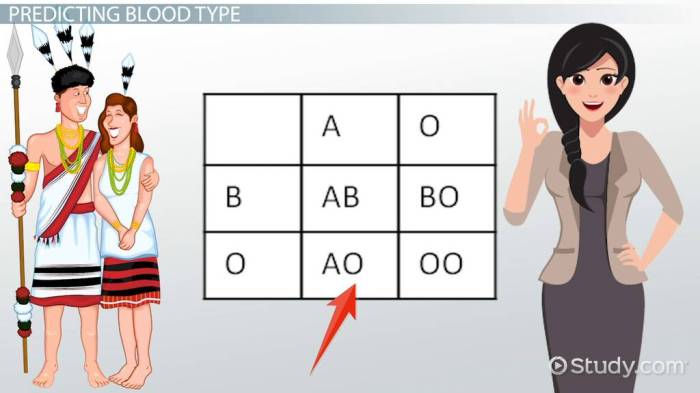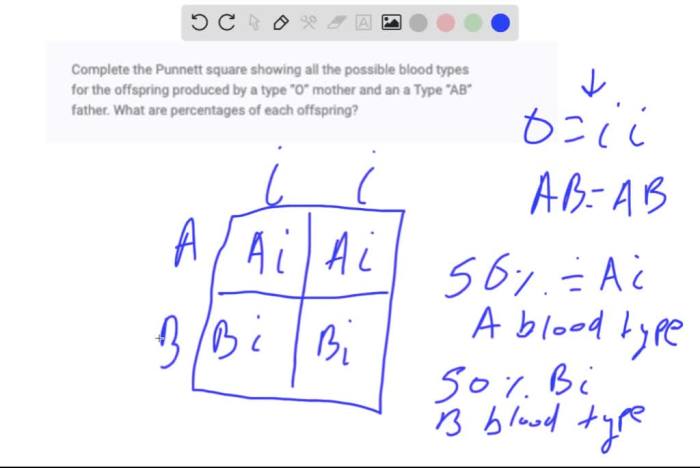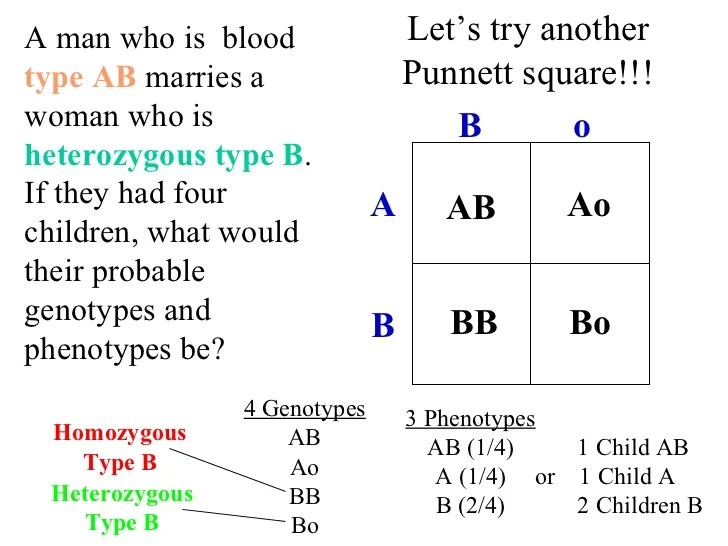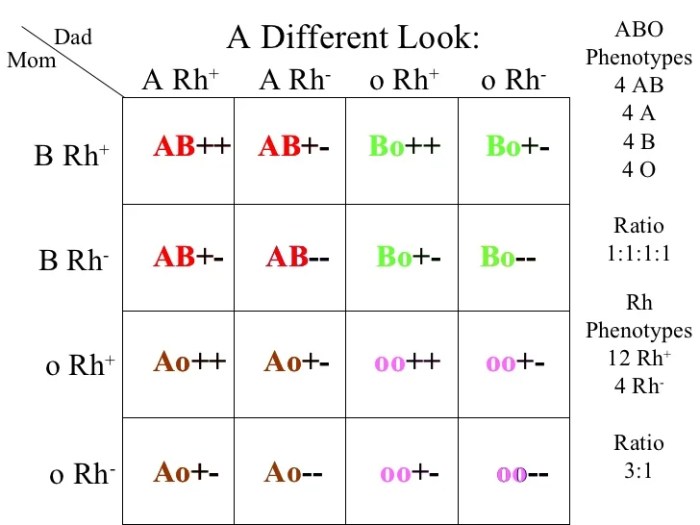Prepare to embark on a captivating exploration of Punnett squares, a cornerstone of genetic analysis, as we delve into the intricacies of blood type inheritance. Through the lens of this interactive Punnett square blood type worksheet, we will unravel the mysteries of blood type determination and its implications in real-world scenarios.
Blood types, classified as A, B, AB, and O, are inherited traits governed by specific genetic principles. Punnett squares provide a powerful tool to visualize and predict the potential blood types of offspring based on the genotypes of their parents.
By understanding the inheritance patterns revealed by Punnett squares, we gain invaluable insights into the fascinating world of human genetics.
Introduction to Punnett Squares: Punnett Square Blood Type Worksheet

Punnett squares are a graphical tool used in genetics to predict the probability of offspring inheriting specific traits. They are named after the British geneticist Reginald Punnett, who first described them in 1905.
Punnett squares are based on the concept of dominant and recessive alleles. An allele is a variant of a gene that determines a particular trait. Each individual has two alleles for each gene, one inherited from each parent. Dominant alleles are those that are expressed in the phenotype (the observable characteristics of an individual), even if only one copy of the allele is present.
Recessive alleles are those that are only expressed in the phenotype if two copies of the allele are present.
Using Punnett Squares
To use a Punnett square, the alleles for each parent are written along the top and side of the square. The possible genotypes of the offspring are then written in the boxes of the square. The genotype is the combination of alleles that an individual has for a particular gene.
The phenotype is the observable expression of the genotype.
For example, if a parent has the genotype Aa for a particular gene, they have one dominant allele (A) and one recessive allele (a). The possible genotypes of their offspring are AA (dominant homozygous), Aa (heterozygous), and aa (recessive homozygous).
The possible phenotypes are dominant (AA and Aa) and recessive (aa).
Punnett Square for Blood Types

Blood type is determined by the presence or absence of specific antigens on the surface of red blood cells. There are four main blood types: A, B, AB, and O. Each blood type is determined by the combination of two alleles, one inherited from each parent.
The A and B alleles are dominant, while the O allele is recessive. This means that if a person inherits one A allele and one O allele, they will have type A blood. If they inherit one B allele and one O allele, they will have type B blood.
If they inherit two A alleles, they will have type AB blood. If they inherit two O alleles, they will have type O blood.
Punnett Square for Blood Types
A Punnett square can be used to determine the possible blood types of offspring. A Punnett square is a grid that shows all possible combinations of alleles that can be inherited from each parent.
To create a Punnett square for blood types, list the possible alleles for each parent along the top and side of the grid. Then, fill in the grid with all possible combinations of alleles. The resulting grid will show the possible blood types of the offspring.
For example, if one parent has type A blood and the other parent has type B blood, the Punnett square would look like this:
“`| | A | O ||—|—|—|| B | AB | BO || O | A | O |“`
The Punnett square shows that the possible blood types of the offspring are AB, A, B, and O.
Example Punnett Square Blood Type Worksheet

A Punnett square blood type worksheet provides a structured way to predict the possible blood types of offspring based on the blood types of their parents. To fill out the worksheet, follow these steps:
Filling Out the Worksheet
- Determine the parents’ blood types:Write the blood type of each parent along the top and left side of the square.
- Create a 4×4 grid:Divide the square into 16 smaller squares.
- Fill in the top and left rows/columns with alleles:For each parent, write their blood type alleles in the top row (for the father) and left column (for the mother).
- Combine alleles in each square:For each square, combine the allele from the top row with the allele from the left column to create the possible blood type of an offspring.
Interpreting the Results
Once the worksheet is filled out, you can interpret the results to determine the probability of each possible blood type:
- Count the number of squares for each blood type:This will give you the number of offspring that are expected to have that blood type.
- Calculate the probability of each blood type:Divide the number of squares for each blood type by the total number of squares (16) to get the probability.
For example, if the worksheet shows 6 squares for blood type A, the probability of having a child with blood type A is 6/16 or 37.5%.
Punnett Square Table Using HTML Tags
You can create a Punnett square table using HTML tags as follows:
| A | B | O | |
|---|---|---|---|
| A | AA | AB | AO |
| B | BA | BB | BO |
| O | OA | OB | OO |
Applications of Punnett Squares in Blood Type Analysis

Punnett squares are invaluable tools in blood type analysis, providing a systematic approach to predict the possible blood types of offspring based on the blood types of their parents. These squares find applications in various scenarios, including blood transfusions and paternity determination.
Blood Transfusions
In blood transfusions, Punnett squares are used to determine blood compatibility between donors and recipients. Blood transfusions involve transferring blood from one individual (donor) to another (recipient). To ensure a safe transfusion, it is crucial to match the blood types of the donor and recipient.
Punnett squares help predict the possible blood types of offspring based on the blood types of their parents.
For example, if a patient with blood type A+ requires a blood transfusion, Punnett squares can be used to determine compatible donors. The patient’s blood type indicates that they have both A and Rh antigens on their red blood cells.
Therefore, a compatible donor must have blood that does not cause an immune reaction in the recipient. Using a Punnett square, it can be determined that donors with blood types A+, A-, O+, and O- are compatible with the recipient.
Paternity Determination, Punnett square blood type worksheet
Punnett squares also play a role in paternity determination. In cases where the paternity of a child is disputed, Punnett squares can be used to determine the likelihood that a particular individual is the father. By analyzing the blood types of the mother, child, and alleged father, Punnett squares can be used to calculate the probability of the alleged father being the biological father.
For instance, if a child has blood type A+ and the mother has blood type O+, Punnett squares can be used to determine the possible blood types of the father. The child must have inherited the A antigen from the father, so the father must have at least one A antigen.
The father could have blood type A+, A-, or AB+. By analyzing the Punnett square, it can be determined that the probability of the alleged father being the biological father is 50%.
Real-World Examples
Punnett squares have been used in numerous real-world cases to analyze blood types. One notable example is the paternity case of Alexander Hamilton. In 2015, Punnett squares were used to analyze the blood types of Hamilton’s descendants and determine his paternity.
The analysis concluded that James Reynolds was the biological father of Hamilton’s son, Philip.
Another example is the use of Punnett squares in blood transfusions. Hospitals routinely use Punnett squares to determine blood compatibility between donors and recipients. This practice has significantly reduced the risk of transfusion reactions and improved the safety of blood transfusions.
Extensions and Activities
To further enhance the understanding and application of Punnett squares, consider the following extensions and activities:
Interactive Punnett Square Simulation
Create an interactive Punnett square simulation using HTML and JavaScript. This simulation should allow users to input the genotypes of parents and observe the possible offspring genotypes and phenotypes. The simulation can be designed to include options for different traits, such as blood type, eye color, or hair texture.
Printable Punnett Square Worksheet
Design a printable Punnett square worksheet for students. This worksheet can include exercises on various inheritance patterns, such as dominant-recessive, codominant, or incomplete dominance. The worksheet should provide clear instructions and examples to guide students through the process of solving Punnett squares.
Additional Resources and Activities
- Provide links to additional resources related to Punnett squares and blood type analysis, such as online simulations, interactive quizzes, or educational videos.
- Organize a classroom activity where students can work in groups to solve Punnett squares for different inheritance patterns.
- Incorporate Punnett squares into a genetics project, such as a research project on the inheritance of a specific trait or a family pedigree analysis.
Detailed FAQs
What is a Punnett square?
A Punnett square is a diagram used to predict the possible genotypes and phenotypes of offspring based on the genotypes of their parents.
How do I use a Punnett square to determine blood type?
To determine blood type using a Punnett square, you need to know the genotypes of the parents. Each parent’s genotype is represented by two letters, one from each parent. The possible genotypes for blood type are AA, AO, BB, BO, and OO.
What are the different blood types?
The different blood types are A, B, AB, and O. Blood type is determined by the presence or absence of two antigens, A and B. People with type A blood have the A antigen, people with type B blood have the B antigen, people with type AB blood have both the A and B antigens, and people with type O blood have neither the A nor the B antigen.